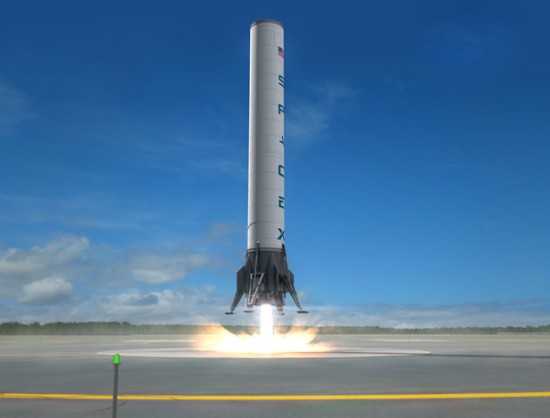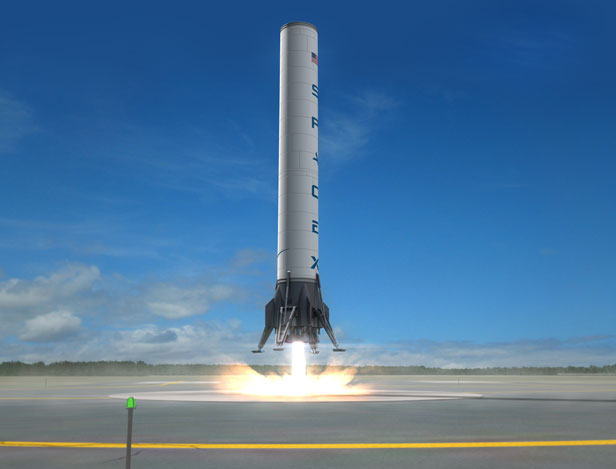Intelligent Machines
Space Companies Hatch Plans for Reusable Rockets
Such a rocket would dramatically reduce the costs of spaceflight—a promise NASA’s space shuttle failed to deliver on.



For decades, companies and space agencies have sought to develop launch vehicles that can be reused. A rocket that could be used dozens or even hundreds of times would reshape the economics of spaceflight by slashing the cost per launch. NASA aimed to do just this with the space shuttle, but the vehicle failed to achieve the promised cost savings. Now two prominent commercial space companies have announced plans for reusable launch vehicles, and their progress is notable.
In a speech at the National Press Club in Washington, D.C., in late September, Elon Musk, the CEO and chief technology officer of SpaceX, announced plans to develop a fully reusable version of the company’s Falcon 9 rocket. First launched last year, the Falcon 9 is a two-stage rocket designed to carry satellites as well as SpaceX’s cargo and crew capsule into space. “It’s a very tough engineering problem, and it wasn’t something I was sure could be solved for a while,” he said about the prospects of building a reusable launch vehicle. “Relatively recently—in the last 12 months or so—I’ve come to the conclusion that it can be solved, and SpaceX is going to try and do it.”
NASA’s space shuttle is the only orbital reusable launch vehicle that’s flown to date, and it was retired this summer after falling far short of its original goals to launch frequently and inexpensively—the agency projected it would fly up to 50 missions per year at an operating cost of $10.5 million per flight. It turned out that the shuttles flew less than five times per year at an operating cost 20 times that.
SpaceX’s approach is to convert the two stages of the Falcon 9 rocket into independent vehicles capable of making return landings at their launch site. The first stage, after separating from the rest of the rocket, would fire its engines to guide itself back to the launch site, extending a set of legs from its base to land vertically. The upper stage, outfitted with the heat shield that SpaceX developed for its Dragon spacecraft, which was designed to transport cargo and eventually crews to and from the space station, would reenter after deploying its payload in space. It would also use its engine for a powered vertical landing.
Musk is backing up his speech with development work. SpaceX has been quietly building an experimental vehicle called Grasshopper to test the vertical landing technology. Grasshopper is a Falcon 9 first stage outfitted with a single engine and landing legs to allow it to take off and land vertically. The vehicle was publically disclosed for the first time the week before Musk’s speech in a regulatory filing with the U.S. Federal Aviation Administration’s Office of Commercial Space Transportation.
“Grasshopper continues our path toward reusability,” SpaceX president Gwynne Shotwell said when asked about Grasshopper at the AIAA Space 2011 conference in Long Beach, California, two days before Musk’s speech. She declined to provide additional details about the project, but did say low-altitude test flights could begin by early next year from a SpaceX site in Texas, pending approval of an experimental permit from the FAA.
SpaceX is not the only company actively working on an orbital reusable launch vehicle. Blue Origin, the secretive aerospace company founded by Amazon.com CEO Jeff Bezos, has NASA funding to mature the design of a space vehicle that could be launched on existing expendable rockets, such as the Atlas V. Eventually, though, Blue Origin plans to replace the Atlas with its own reusable orbital launch vehicle, and is using part of the $22 million Commercial Crew Development award it received from NASA earlier this year to work on an engine for that rocket.
“We intend to fly our own Blue Origin reusable launch vehicles that will take [our] space vehicle up and make that system much more affordable,” said Rob Meyerson, program manager at Blue Origin, at AIAA Space 2011. The company has not disclosed development schedules or other technical details about its planned vehicle. However, the support the company has from NASA, coupled with the financial backing provided by Bezos, makes the company’s effort worth watching.
This is not the first time companies have shown an interest in building reusable launch vehicles. In the late 1990s, several companies, including Kistler Aerospace and Rotary Rocket Company, had ambitious plans for orbital reusable launch vehicles, but their projects never materialized.
What’s the difference this time around? Charles Lurio, a space industry consultant and publisher of The Lurio Report newsletter, says current companies have made more progress than earlier firms, including building and flying hardware. “They have a fair shot at making it work,” he says, “but nothing’s guaranteed.”